Crankshaft SSANGYONG KORANDO 2013 User Guide
[x] Cancel search | Manufacturer: SSANGYONG, Model Year: 2013, Model line: KORANDO, Model: SSANGYONG KORANDO 2013Pages: 1336, PDF Size: 92.18 MB
Page 378 of 1336
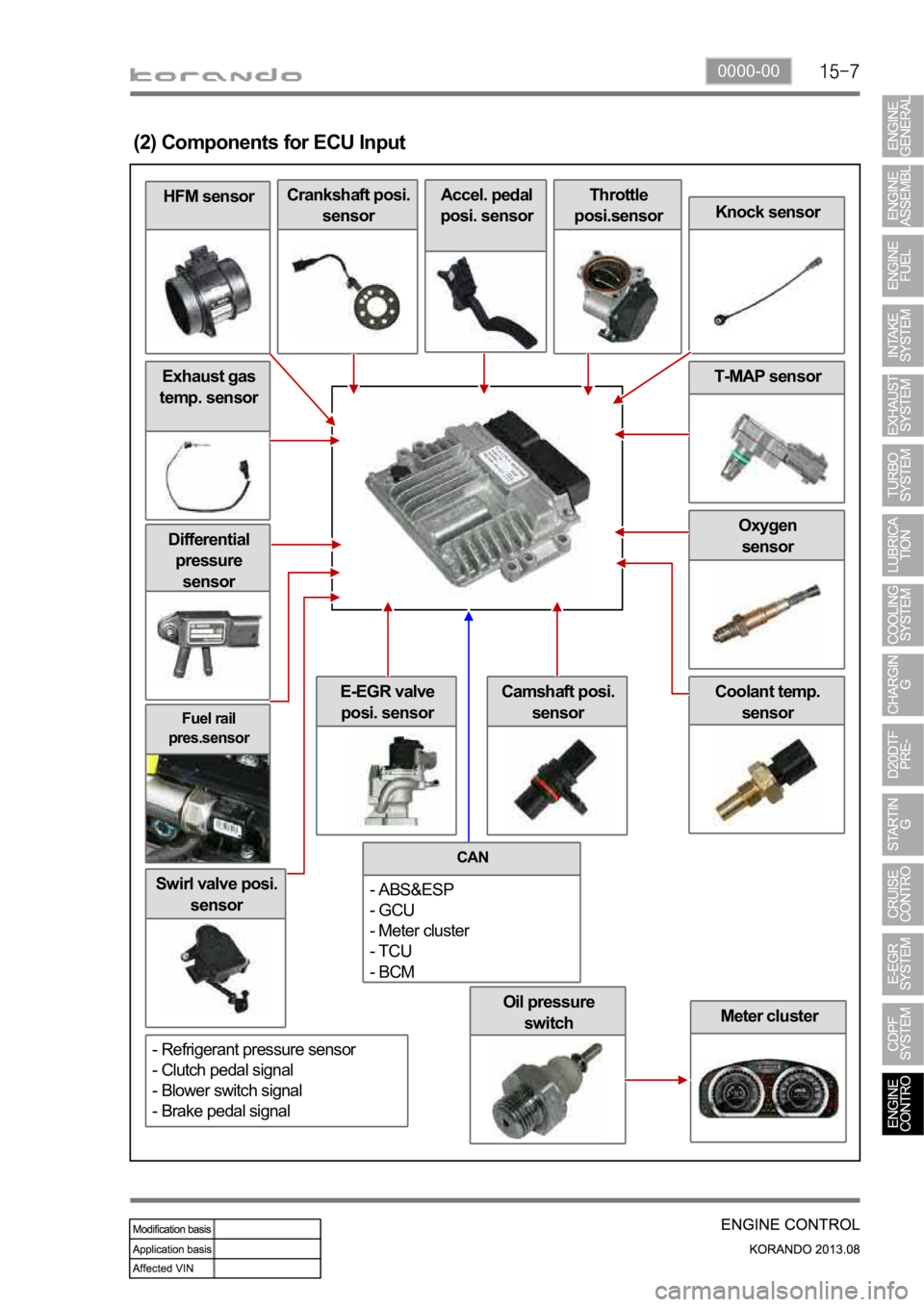
0000-00
Oil pressure
switch
Fuel rail
pres.sensor
Differential
pressure
sensor
Swirl valve posi.
sensor
Meter cluster
Coolant temp.
sensorE-EGR valve
posi. sensor
Oxygen
sensor
Exhaust gas
temp. sensor
HFM sensor
(2) Components for ECU Input
Crankshaft posi.
sensorAccel. pedal
posi. sensorThrottle
posi.sensor
Knock sensor
T-MAP sensor
Camshaft posi.
sensor
CAN
- ABS&ESP
- GCU
- Meter cluster
- TCU
- BCM
- Refrigerant pressure sensor
- Clutch pedal signal
- Blower switch signal
- Brake pedal signal
Page 380 of 1336
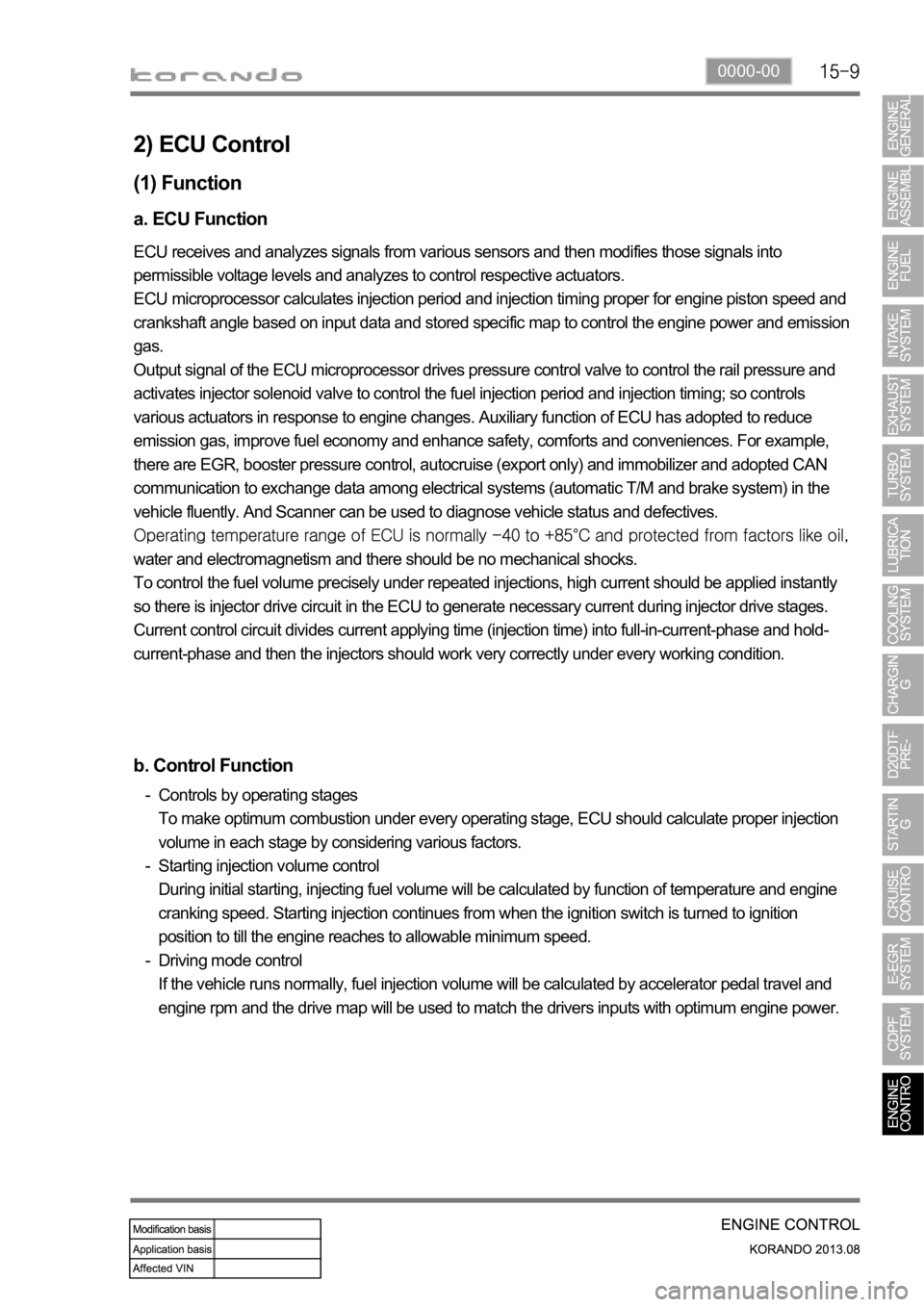
0000-00
2) ECU Control
(1) Function
a. ECU Function
ECU receives and analyzes signals from various sensors and then modifies those signals into
permissible voltage levels and analyzes to control respective actuators.
ECU microprocessor calculates injection period and injection timing proper for engine piston speed and
crankshaft angle based on input data and stored specific map to control the engine power and emission
gas.
Output signal of the ECU microprocessor drives pressure control valve to control the rail pressure and
activates injector solenoid valve to control the fuel injection period and injection timing; so controls
various actuators in response to engine changes. Auxiliary function of ECU has adopted to reduce
emission gas, improve fuel economy and enhance safety, comforts and conveniences. For example,
there are EGR, booster pressure control, autocruise (export only) and immobilizer and adopted CAN
communication to exchange data among electrical systems (automatic T/M and brake system) in the
vehicle fluently. And Scanner can be used to diagnose vehicle status and defectives.
water and electromagnetism and there should be no mechanical shocks.
To control the fuel volume precisely under repeated injections, high current should be applied instantly
so there is injector drive circuit in the ECU to generate necessary current during injector drive stages.
Current control circuit divides current applying time (injection time) into full-in-current-phase and hold-
current-phase and then the injectors should work very correctly under every working condition.
b. Control Function
Controls by operating stages
To make optimum combustion under every operating stage, ECU should calculate proper injection
volume in each stage by considering various factors.
Starting injection volume control
During initial starting, injecting fuel volume will be calculated by function of temperature and engine
cranking speed. Starting injection continues from when the ignition switch is turned to ignition
position to till the engine reaches to allowable minimum speed.
Driving mode control
If the vehicle runs normally, fuel injection volume will be calculated by accelerator pedal travel and
engine rpm and the drive map will be used to match the drivers inputs with optimum engine power. -
-
-
Page 390 of 1336
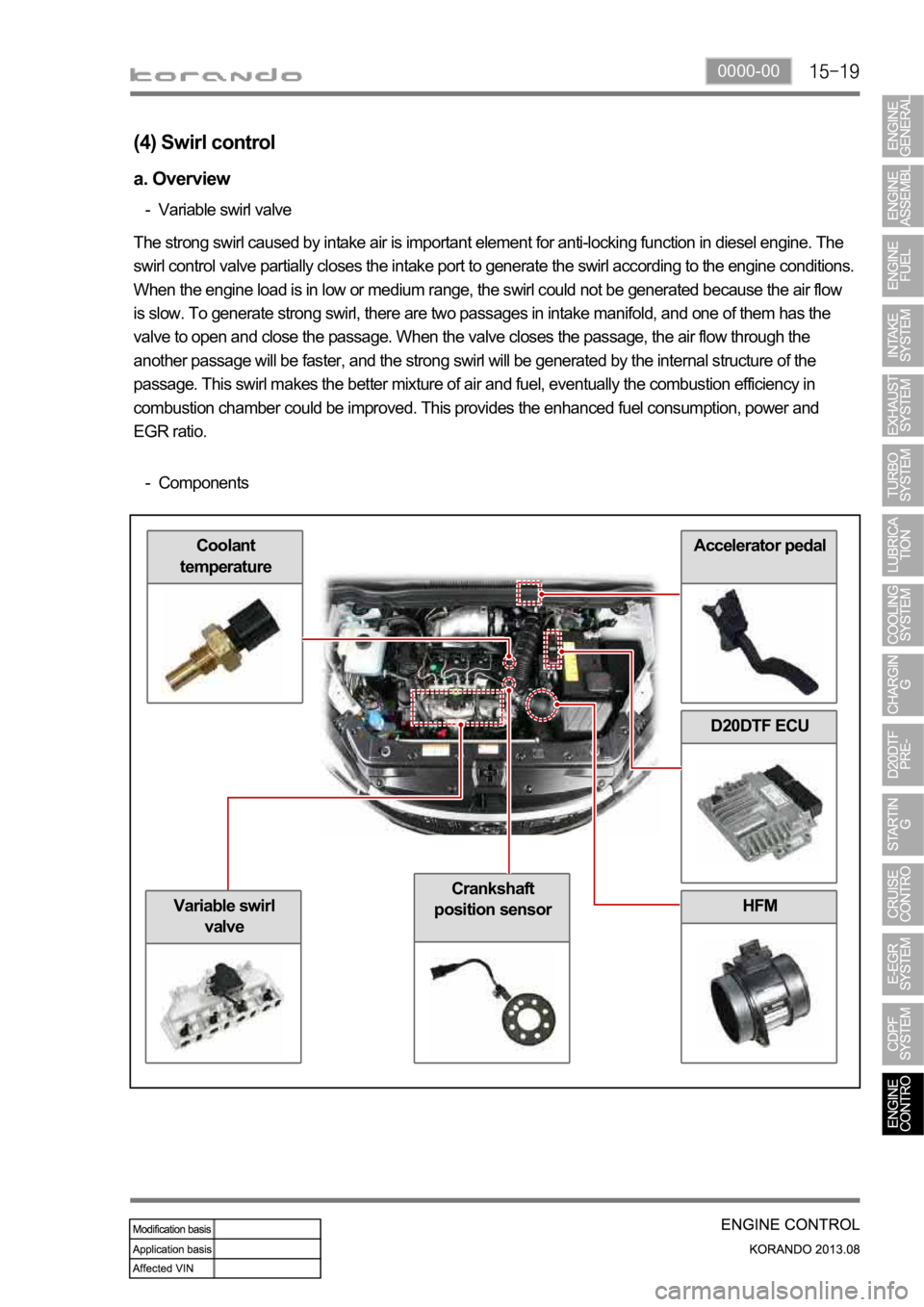
0000-00
HFM
Accelerator pedalCoolant
temperature
(4) Swirl control
a. Overview
Variable swirl valve -
The strong swirl caused by intake air is important element for anti-locking function in diesel engine. The
swirl control valve partially closes the intake port to generate the swirl according to the engine conditions.
When the engine load is in low or medium range, the swirl could not be generated because the air flow
is slow. To generate strong swirl, there are two passages in intake manifold, and one of them has the
valve to open and close the passage. When the valve closes the passage, the air flow through the
another passage will be faster, and the strong swirl will be generated by the internal structure of the
passage. This swirl makes the better mixture of air and fuel, eventually the combustion efficiency in
combustion chamber could be improved. This provides the enhanced fuel consumption, power and
EGR ratio.
Components -
D20DTF ECU
Crankshaft
position sensor
Variable swirl
valve
Page 395 of 1336
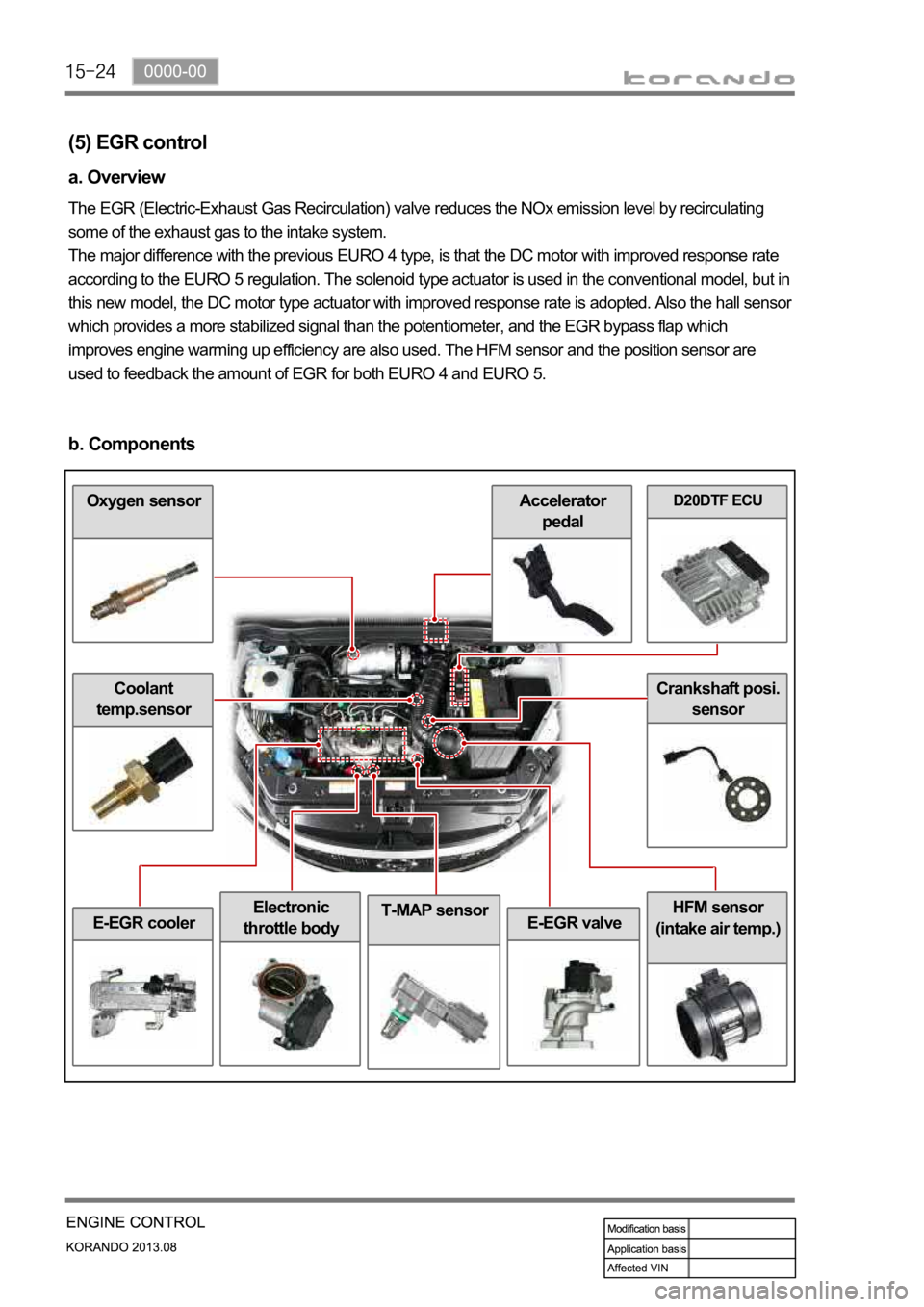
T-MAP sensor
D20DTF ECUOxygen sensor
Electronic
throttle bodyHFM sensor
(intake air temp.)
Coolant
temp.sensor
E-EGR valve
Crankshaft posi.
sensor
Accelerator
pedal
E-EGR cooler
(5) EGR control
a. Overview
The EGR (Electric-Exhaust Gas Recirculation) valve reduces the NOx emission level by recirculating
some of the exhaust gas to the intake system.
The major difference with the previous EURO 4 type, is that the DC motor with improved response rate
according to the EURO 5 regulation. The solenoid type actuator is used in the conventional model, but in
this new model, the DC motor type actuator with improved response rate is adopted. Also the hall senso
r
which provides a more stabilized signal than the potentiometer, and the EGR bypass flap which
improves engine warming up efficiency are also used. The HFM sensor and the position sensor are
used to feedback the amount of EGR for both EURO 4 and EURO 5.
b. Components
Page 399 of 1336
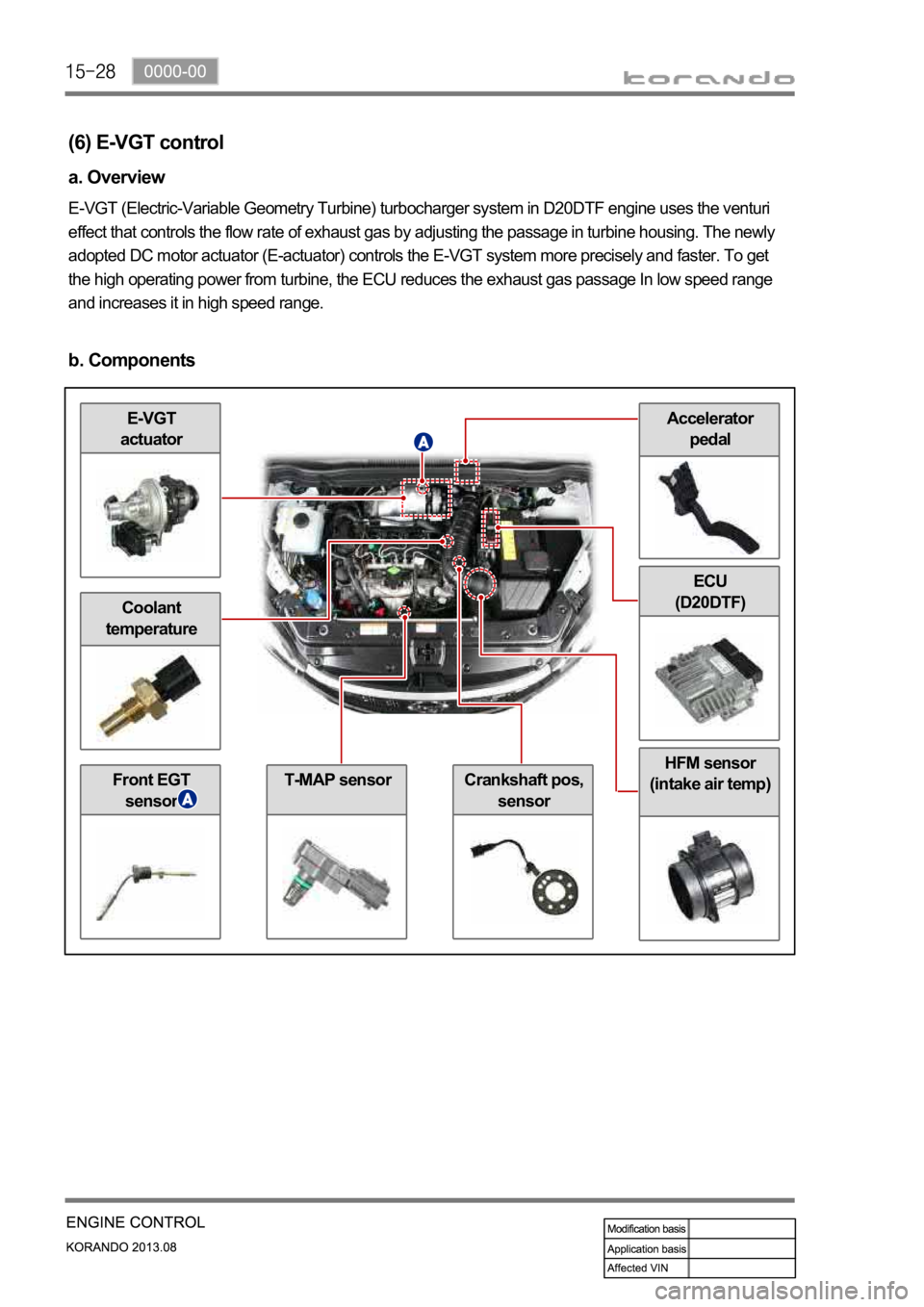
Accelerator
pedalE-VGT
actuator
Coolant
temperature
Front EGT
sensorT-MAP sensorCrankshaft pos,
sensor
HFM sensor
(intake air temp)
ECU
(D20DTF)
(6) E-VGT control
a. Overview
E-VGT (Electric-Variable Geometry Turbine) turbocharger system in D20DTF engine uses the venturi
effect that controls the flow rate of exhaust gas by adjusting the passage in turbine housing. The newly
adopted DC motor actuator (E-actuator) controls the E-VGT system more precisely and faster. To get
the high operating power from turbine, the ECU reduces the exhaust gas passage In low speed range
and increases it in high speed range.
b. Components
Page 423 of 1336
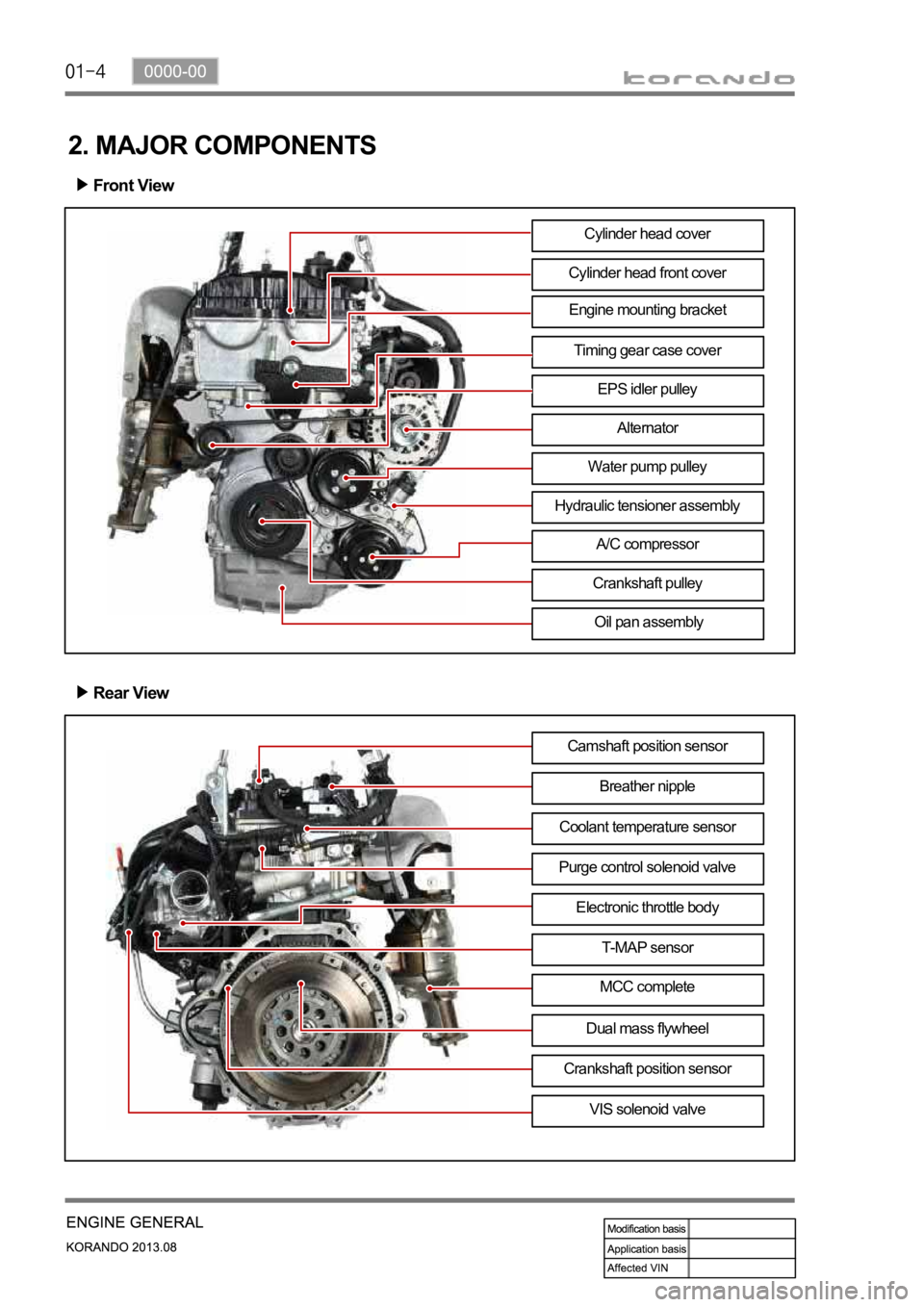
Engine mounting bracket
2. MAJOR COMPONENTS
Front View
Cylinder head front cover
Timing gear case cover
EPS idler pulley
Alternator
Water pump pulley
A/C compressor
Crankshaft pulley
Oil pan assembly
Rear View
Camshaft position sensor
Breather nipple
Purge control solenoid valveCoolant temperature sensor
Electronic throttle body
T-MAP sensor
MCC complete
VIS solenoid valve Cylinder head cover
Dual mass flywheel
Crankshaft position sensor
Hydraulic tensioner assembly
Page 424 of 1336
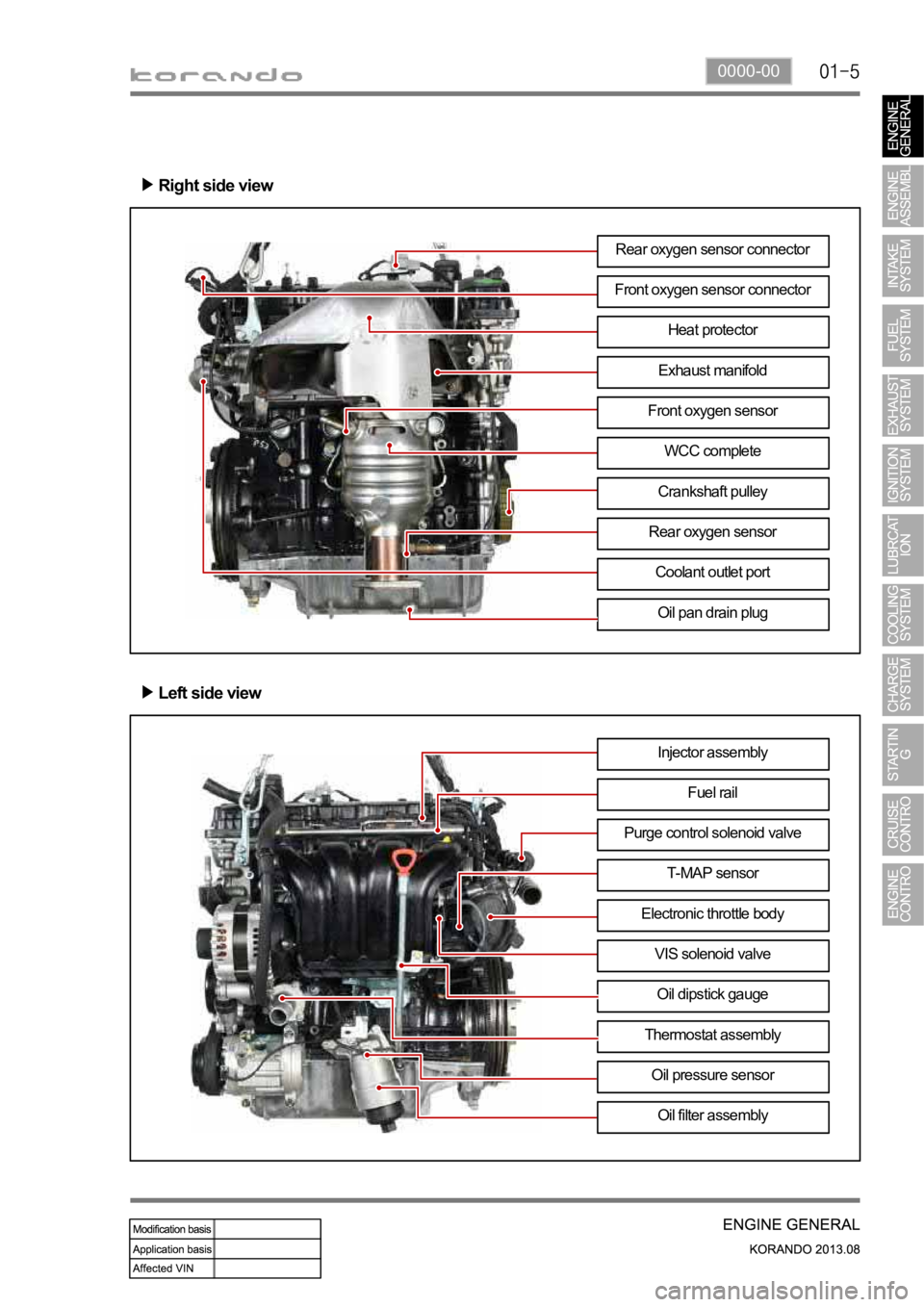
0000-00
Right side view
Left side view
Rear oxygen sensor connector
Front oxygen sensor connector
Exhaust manifoldHeat protector
Front oxygen sensor
WCC complete
Crankshaft pulley
Oil pan drain plug
Rear oxygen sensor
Coolant outlet port
Injector assembly
Fuel rail
T-MAP sensor Purge control solenoid valve
Electronic throttle body
VIS solenoid valve
Oil dipstick gauge
Oil filter assembly
Thermostat assembly
Oil pressure sensor
Page 437 of 1336
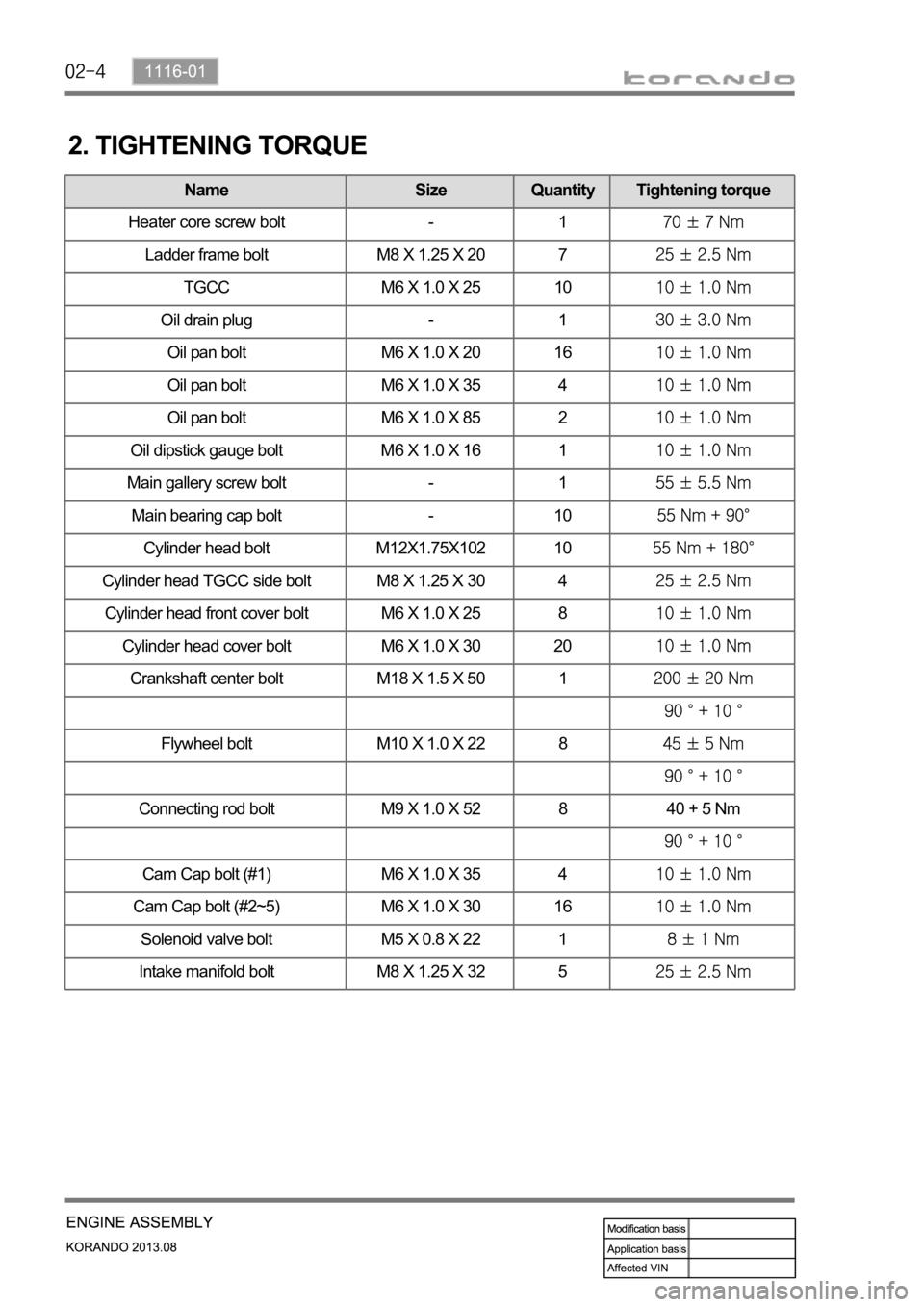
Name Size Quantity Tightening torque
Oil pan bolt M6 X 1.0 X 20 16
Oil pan bolt M6 X 1.0 X 35 4
Oil pan bolt M6 X 1.0 X 85 2
Oil dipstick gauge bolt M6 X 1.0 X 16 1
Camshaft cap M6 X 1.0 X 30 20
Main gallery screw bolt - 1
Main bearing cap bolt - 10
Cylinder head bolt M12X1.75X102 10
Cylinder head TGCC side bolt M8 X 1.25 X 30 4
Cylinder head front cover bolt M6 X 1.0 X 25 8
Cylinder head cover bolt M6 X 1.0 X 30 20
Crankshaft center bolt M18 X 1.5 X 50 1
Flywheel bolt M10 X 1.0 X 22 8
Connecting rod bolt M9 X 1.0 X 52 8 40 + 5 Nm
Cam Cap bolt (#1) M6 X 1.0 X 35 4
Cam Cap bolt (#2~5) M6 X 1.0 X 30 16
Solenoid valve bolt M5 X 0.8 X 22 1
Intake manifold bolt M8 X 1.25 X 32 5
2. TIGHTENING TORQUE
Name Size Quantity Tightening torque
Heater core screw bolt - 1
Ladder frame bolt M8 X 1.25 X 20 7
TGCC M6 X 1.0 X 25 10
Oil drain plug - 1
Oil pan bolt M6 X 1.0 X 20 16
Oil pan bolt M6 X 1.0 X 35 4
Oil pan bolt M6 X 1.0 X 85 2
Oil dipstick gauge bolt M6 X 1.0 X 16 1
Page 442 of 1336
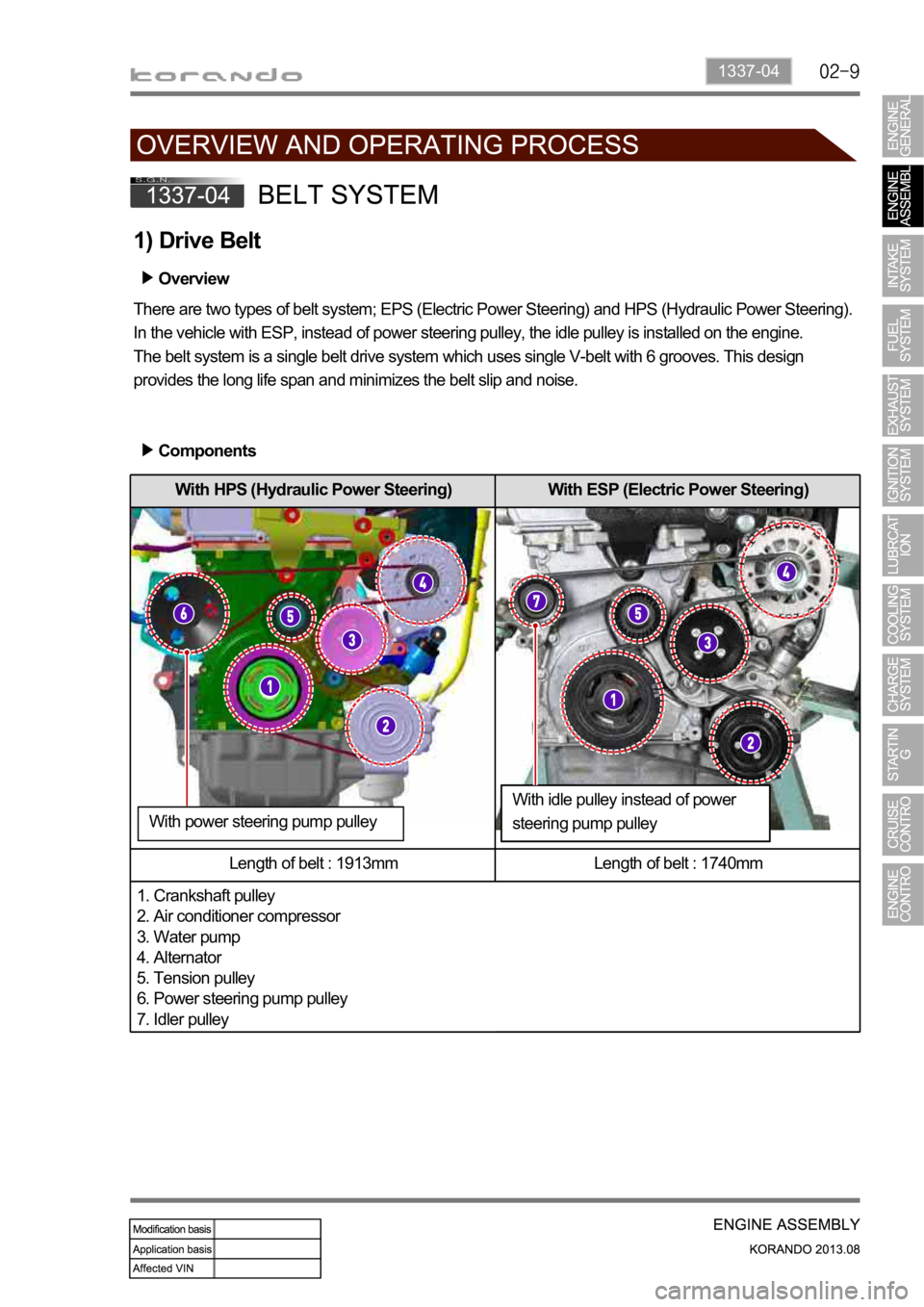
1337-04
With HPS (Hydraulic Power Steering) With ESP (Electric Power Steering)
Length of belt : 1913mm Length of belt : 1740mm
1. Crankshaft pulley
2. Air conditioner compressor
3. Water pump
4. Alternator
5. Tension pulley
6. Power steering pump pulley
7. Idler pulley
1) Drive Belt
Overview
There are two types of belt system; EPS (Electric Power Steering) and HPS (Hydraulic Power Steering).
In the vehicle with ESP, instead of power steering pulley, the idle pulley is installed on the engine.
The belt system is a single belt drive system which uses single V-belt with 6 grooves. This design
provides the long life span and minimizes the belt slip and noise.
Components
With idle pulley instead of power
steering pump pulley With power steering pump pulley
Page 444 of 1336

1337-04
3) Crankshaft Pulley (CRS)
The strut type tensioner automatically adjusts the belt tension to provide the reliability and durability for
the system. And, the belt tension is decreased to minimize the friction loss and improve the belt
operating noise.Overview
Location
Crankshaft pulley (CRS)
Timing mark